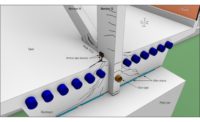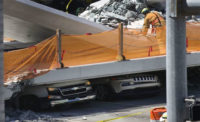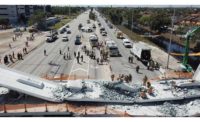NTSB Vice Chairman Slams Design-Construction Team for Miami Bridge Collapse
Included within the final pages of the National Transportation Safety Board's final report on the pedestrian bridge collapse at Florida International University last year is Vice Chairman Bruce Landsberg's 850-word-long lament on the numerous failures that led to the tragedy. As ENR did previously with the NTSB's 30 findings from its investigation, ENR is publishing Landsberg's statement here, in full, without edit, for our readers' convenience. Italicized words are included to duplicate the NTSB's publication of the statement.
Board Member Statement Vice Chairman Landsberg filed the following concurring statement on October 28, 2019.
Concurring Statement of Vice Chairman Bruce Landsberg re Miami Pedestrian Bridge Collapse
"A bridge-building disaster should be incomprehensible in today’s technical world. We have been building bridges in this country for over two hundred years, and long before that in other parts of the world. The science should be well sorted out by now – and for the most part, it is. The investigation clearly highlighted basic design flaws and a complete lack of oversight by every single party that had responsibility to either identify the design errors or stop work and call for a safety stand-down, once it was clear that there was a massive internal failure.
"The 'what' is very clear but the 'why' is more elusive. Despite the public’s anger, distress, and disappointment, none of the responsible organizations had any intent for this tragic event to occur or to cause any injury or loss of life. Sadly, good intentions do not suffice for competence and diligence.
"Engineering schools will use this as a landmark case study for years – and they should. The Engineer of Record (EOR) employed by FIGG Bridge Engineers, Inc., was experienced, but his calculations were erroneous. Reflection on this event should go far beyond merely a technical review. The checks and balances that were required by the Florida Department of Transportation (FDOT) and American Association of State Highway and Transportation Officials guidance and incumbent upon Louis Berger (LB), the peer-reviewing organization, were completely lacking. LB lowered their bid to review the project by 43 percent in order to get the business, but also reduced the scope of the review. The reason given was there wasn’t enough money in the project to cover their efforts. That’s both disingenuous and unconscionable. It also was in violation of FDOT’s requirement that there be an independent second set of eyes to review everything – not just what was economically convenient.
"It is likewise incomprehensible and unethical that LB would even bid on a job for which they lacked the requisite qualifications. That FDOT, which was supposed to review the plans, did not know, or think to ask, about their qualifications is more than just an oversight. It’s just plain sloppy. Ditto for FIGG. FDOT claimed a technical error on the FDOT website and then, after the collapse, fabricated a disclaimer that they are not responsible for the data that they post. That’s unacceptable in my view - either ensure the information is accurate or don’t post it.
"The bridge was not properly designed, and there was no qualified oversight on that design. When the inevitable began to happen – a creeping, catastrophic material failure, nobody did anything, despite what NTSB Chairman Sumwalt accurately described as the “bridge screaming at everyone that it was failing.” Why?
"Once the cracking became evident, not one of the organizations involved was willing to take the essential and unpopular step to call a halt and close the road. This is similar to the circumstances of the space shuttle Challenger disaster where the decision was made to launch in extremely cold weather. The engineers recommended against it because the O-Rings that were critical to fuel system integrity would be operating outside their design parameters. Rationalization, optimism, and schedule pressure contributed to what has been described in management training circles as “Group Think.” Strong and confident personalities persuade everyone that everything will be OK. Despite misgivings and technical expertise that advise against such action, the team moves forward as a group.
"It appears that the same mindset was in play here, in every organization: FIGG, LB, MCM (the construction company), Bolton Perez (the engineering firm overseeing the bridge construction), FDOT, and finally, Florida International University. It also appears that every organization absolved themselves of responsibility by rationalizing that if the EOR says it’s OK, it must be OK, and if anything bad happens – it’s on him. That is not the intent of peer review or safety oversight, and certainly fails the system of checks and balances in place to prevent catastrophes like these.
"We’ve learned this the hard way too many times in transportation modes. The NTSB’s stated role is not to lay blame, but some would say that’s exactly what we do when we apportion causation. The human failing that affects all of us is complacency. It is not a term the NTSB uses often, but in my opinion, it is present in nearly every accident and crash. We are creatures of habit, and when we become comfortable through long repetitive experience, the guard often comes down - periodically with disastrous results. This is precisely what safety management systems are designed to prevent – to trap errors in process before they become catastrophes. While disasters may be perfectly clear in hindsight, the best organizations take proactive measures - constantly. Schedule pressure, economics, overconfidence, and complacency all work to counter good intentions and too often create tragedy.
"It is my fervent hope that the organizations involved will take the NTSB recommendations seriously and quickly implement them. The lives lost and the families disrupted deserve at least that much."





